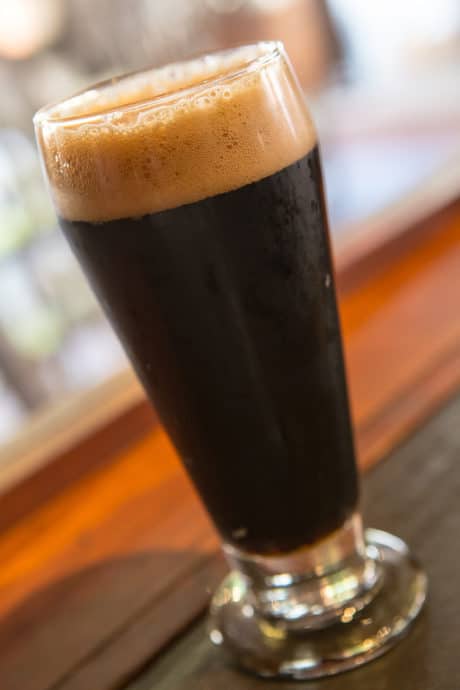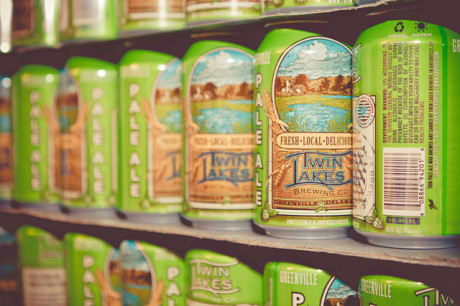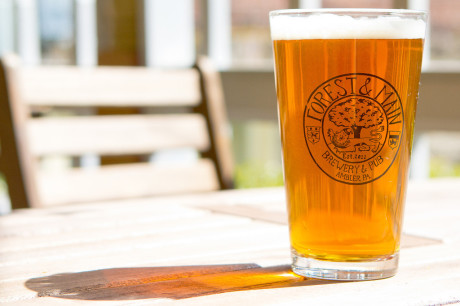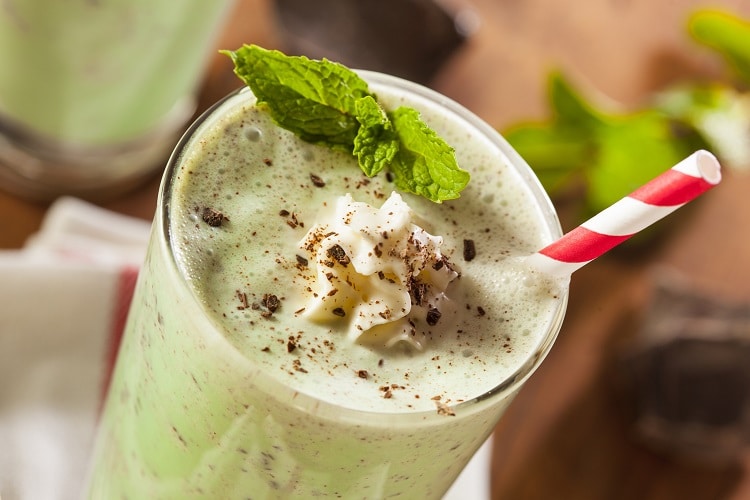Benjamin Franklin once said “Beer is proof that God loves us and wants us to be happy.” This charming quote has graced many a pint glass, t-shirt, coaster and barroom wall. It invokes images of good ol’ Poor Richard tossing back frothy mugs of ale in a rustic tavern while regaling pub patrons with stories of bifocals and lightning rod mishaps.
While it is a romantic quote indeed, the truth is that Ben never said it! What he actually said was “Behold the rain which descends from heaven upon our vineyards, there it enters the roots of the vines, to be changed into wine, a constant proof that God loves us, and loves to see us happy.” In my nearly nine years slinging suds at a local brewpub and seven years peddling beer at a large distributor, I have learned much about beer and seen many a beer myth perpetrated that would have Mr. Franklin rolling over in his grave.
I believe I owe it to Mr. Franklin, to all of you and to beer itself to set some records straight, to right some wrongs, and to spread the truth that has long been shrouded in myth and inaccuracy!
Myth #1 – “You can’t get cold beer warm. It will skunk it.”
You have all heard this one. And I’m betting that most of you believe it to be true. No! Not true! I explain this at least three times a week and almost every time I can see that the person I’m attempting to educate thinks that I am a complete dunce. Now they may be correct in many circumstances but not this one.
Consider for starters that lagers are fermented at lower temperatures. This means your “cold-filtered and cold as the Rockies” beers have been cold at some point and they find their way to your local beer store having changed temperature from cold to room temperature at least one time.
Next, consider that many of the beers you purchase have been transported to you in large trailers that are not temperature controlled at all. Was it a hot summer’s trek from Oregon to you? Perhaps your brew came from Maine to your bottle shop in the dead of winter. More temperature changes and it still tastes great! Now I’m not advocating multiple or extreme temperature changes, but don’t be afraid to pick up a cold case and then let it change to cellar temperature in a cool, dark place.
So what does “skunk” beer? The answer is light. The hops in your beer are delicate and very light sensitive. Even minimal exposure to ultraviolet light can pulverize these hoppy little molecules of goodness, causing them to become “light struck.” When this happens, small parts of these destroyed molecules bind with sulfur atoms, the byproduct of which creates that skunky flavor and aroma.
So you see, it isn’t the hot sun that skunks your beer or even the change in temperature—the bright sun is the culprit! The next time you set your beer down in a bright sunny spot, expect a possible difference in taste when you pick it up and remember it is that cursed sunlight that is to blame.
Myth #2 – “I don’t like dark beer because it is too heavy.”
 Now it may be said that you don’t prefer dark beer for any number of reasons. Perhaps you have sampled an imperial stout that has far too much coffee or dark chocolate for your taste. Maybe that Guinness that you tried has a bit too much of a peaty flavor for you. It’s quite possible that you have come across a black IPA and you found it far too bitter or piney. And in some of these cases that dark beer might have been heavy by your standards.
Now it may be said that you don’t prefer dark beer for any number of reasons. Perhaps you have sampled an imperial stout that has far too much coffee or dark chocolate for your taste. Maybe that Guinness that you tried has a bit too much of a peaty flavor for you. It’s quite possible that you have come across a black IPA and you found it far too bitter or piney. And in some of these cases that dark beer might have been heavy by your standards.
But the truth of the matter is that the color of your beer has absolutely nothing to do with how “heavy” your beer is. Regardless of whether you mean calories or body when you refer to a beer as heavy, it does not hold true that all darker beers are heavier than lighter-colored beers.
Let’s start by explaining how a beer achieves its color. This has to do with the roast of the malt used. Simply put, there are many types of malt used in the brewing process that have many different qualities and one of those qualities derives from how long and at what temperature the malt was kilned. The longer the time and the higher the temperature, the more dark coloration and roasty flavors the malt will impart. But this has no effect on calories. Think of burning a piece of toast. It will taste more burnt and bitter but it is still a piece of bread with the same amount of calories. And that Guinness that you find to be too “heavy” or “filling” actually has less calories than a Budweiser.
Now let’s get into the body of a beer. Generally speaking, ales are often darker in color and more full-bodied than lagers, but this does not hold true simply based on color. Consider for example the Schwarzbier or the Dunkel, a black lager and a dark lager, respectively. These are brews that are darker in color but typically have a lighter body.
The moral of the story: don’t be afraid to give those beers from the dark side a chance. They may be as light in body and low in calories as many of your favorite golden-hued brews.
 Myth #3 – “I don’t like cans. They give my beer a metallic taste and bottles are better anyway.”
Myth #3 – “I don’t like cans. They give my beer a metallic taste and bottles are better anyway.”
I’m not going to argue the fact that you prefer drinking from a bottle to drinking from a can. Bobby Brown would insist that it is your prerogative and I am inclined to agree with him, even though I think you should drink from a glass whenever possible. But many folks actually believe that bottles are better (they aren’t; see myth #1…we debunked this already since bottles let light in while cans do not) or that cans impart some sort of metallic taste to beer.
Cans do not impart a metallic taste on beer at all. According to CraftCans.com, “the aluminum cans used to package beer have a water-based polymer lining that eliminates any metallic contamination or flavors.” Simply put, there is a liner between the metal and your beer. The only way you taste any metal is if you have uber sensitive taste buds and you detect it as your lips touch the mouth of the can while you sip. But like I said earlier and CraftCans.com suggests, brewers would prefer you pour their beverage into a glass, which would eliminate the potential for your super human Stan Lee-style tongue to detect that aluminum flavor from the edge of the can.
It would seem that craft breweries agree, as more and more of them opt for canning either instead of or alongside of bottling. Entire shelves of craft cans can be seen in bottle shops and distributors just beckoning to the potential purchaser. Doesn’t it seem crazy to pass on so many terrific ales and lagers based upon a myth? Well now you know the truth. So next time someone tells you that they taste the aluminum, tell them to can it!
Myth #4 – “I don’t drink beer because beer makes you fat.”
While few would disagree that over-consumption of beer can lead to weight gain, to simply assume that beer is to blame for all of those super sexy “beer bellies” out there is just unfair. Just like your health teacher, doctor, mother, gym rat uncle and cousin’s best friend told you, inactivity and excessive caloric intake make you fat. In other words, put the pizza and chips down, get off of your couch and take a lap once in a while so you can enjoy a few beers without having to loosen your belt a notch or two.
What you should know about this godly nectar and weight gain is how beer is metabolized. Most of us understand that our liver is responsible for alcohol metabolism but we don’t know that it is responsible for hundreds of other functions. Crafty sucker huh? One of those functions is fat metabolism. That little powerhouse releases enzymes that help break down fats for digestion. But when you drink beer, your liver goes into beast mode and decides to make alcohol metabolism a top priority. At this point, fat metabolism is put on hold. You can do the math or use the Google from there.
Since most people enjoy a few beers with or before eating food, imagine all of those calories not only from the beer but also the food just sitting around waiting to be burned off. While all of that alcohol is being handled by your trusty, faithful liver, your body gets all sorts of angry with you and stores those excess calories as fat! What a jerk!
But beer can be part of a healthy, fit lifestyle as long as you remember that it is as much a luxury as cheesecake or ice cream. It is a treat and you should plan on doing the exercise or activity necessary to maintain that trim waistline when enjoying it. Follow the In My ExBEERience plan: stay active, eat clean and healthy as often as possible and don’t waste your beer calories on bad beer!
 Myth #5 – “Ales are stronger than lagers.”
Myth #5 – “Ales are stronger than lagers.”
I don’t know where this one came from but I will assume that it all started when your father first put down his Red Lady (that’s High Life to you and I) and sipped on an imported Belgian ale or newfangled “microbrew.” Undoubtedly he tasted some style of ale that was much more potent than the watery lager he was used to and incorrectly made the assumption that all ales were stronger, which he then spread to his family and friends.
But this one is easy to dispel as long as we understand that there are many types of lagers and ales, all of which differ in ABV depending upon which particular type we are talking about.
Let’s walk through one of my recent beer tasting menus. I started my evening at Armstrong Ales in Phoenixville with a tasty 4% English bitter, which is a style of ale that typically falls in the 3–5% ABV range. I then headed home to enjoy a few more brews starting with a Dortmunder lager, which generally falls between 4 and 6% ABV (my choice was an awesome Great Lakes Dortmunder Gold at 5.8%). Following that up, I had a Ballast Point Sculpin. Sculpin is an outstanding India Pale Ale that happens to have a 7% ABV that fits into the 5.5–7.5% average for the IPA style. I finished off my sipping session with a Troegs Troegenator Doublebock. Troegenator, clocking in at a warming 8.2% ABV, is a doppelbock, which is a lager style that falls between 6.5 and 9% ABV. Let’s check out the findings:
English bitter ale < Dortmunder lager < India pale ale < doppelbock (lager)
What does that mind-bending mathematical mess mean? Myth debunked!
Myth #6 – “Beer should be served ice cold.”
This is a myth that has been repeatedly shoved down our throats by Big Beer’s advertising. Slogans like “cold as a mountain stream and smooth as its name” or “the coldest tasting beer in the world” have bombarded us for years. Commercials depicting entire homes turned icebox to keep brews cold or ice climbers delivering your beer play repeatedly while you try to enjoy sporting events on your television. And remember that creepy penguin!? “Dooby dooby dooo.” I wanted to choke that thing.
The message that every one of these ads sends is that you should consume your beer while it is ice cold. What a great way to ruin a potentially good beer. Studies have shown that foods and beverages enjoyed at warmer temperatures send stronger signals to the part of the brain that perceives taste. Ice cold temperatures actually numb your taste buds and can hide some of the aromas present in your tasty brew! And for goodness sake don’t use a frosted glass unless you prefer to water down your beer. Most beer should be served somewhere between cellar temperature and room temperature, and each style of beer has an optimal serving temperature range.
Check out this guide on Ratebeer.com for assistance in properly serving your favorite brews. You may discover a whole world of flavors that you never knew were there!
Now that we have debunked some fairly major myths surrounding beer, you can go forth and spread the truth. Do your part to put an end to these inaccuracies once and for all. Use your newfound knowledge to impress your friends, explore the farthest reaches in the world of beer and achieve maximum enjoyment when sampling your favorite brews. And if you see that “Dooby dooby doo” penguin, give him a kick in the rear for me!
Explore even more beer myths being debunked and day-to-day beer reviews on Kerry Watson’s In My ExBEERience.
- Photography: Nina Lea Photograhy





3 Comments